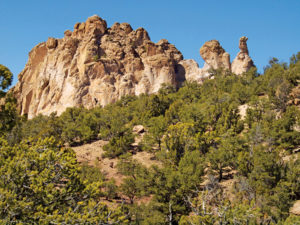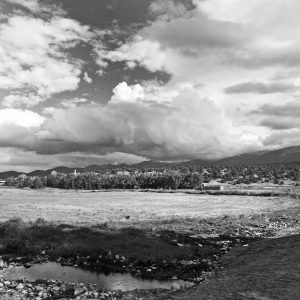By George Sibley
“Creative destruction” is a term we’re most familiar with in the context of capitalist economics: the restless flow and ebb of capital in its often mindless, generally heartless, search for The Next Big Thing – steam abandoned for internal combustion, coal yielding to natural gas yielding to solar, typewriters losing to computers, with individual lives and communities at least temporarily devastated if not destroyed as whole industries disappear here and new ones pop up a thousand miles away. Creative destruction.
But creative destruction happens in the natural world, too. The restless flow of wind and water, working on the restless heaving and shifting of earth, the mindless processes of mountains being moved by moving water to create floodplains, floodplains being stripped by wind and cracked and wrinkled tectonically by earth’s fire to create more mountains. Also created in these natural processes is shock-and-awe magnificence, a chaotic splendor that, in the right light at the right time of day, is astoundingly beautiful, and like Faust we want to stop it there, preserve it forever: Verweile doch; du bist so schön – “Stay a while; you are so beautiful.” And we then designate it a National Park or Monument.
We have two spectacular manifestations of this creative destruction in Central Colorado: the Black Canyon of the Gunnison National Park and the Great Sand Dunes National Park and Preserve, and hundreds of thousands of people from all over the planet come to pay homage (and a few dollars too) to ponder these exemplars of water and wind erosion on an extravagant scale. *
This year marks the centennial of the creation of our National Park Service (NPS) – a centennial worth celebrating. Whether or not it has been “America’s Best Idea,” it has certainly been an important idea in the evolution of America’s stumble and fumble toward a functioning democratic republic by, for and of the people, as opposed to the aristocratic “King’s Forest” model of the Old World.
[InContentAdTwo]
Congress set aside the world’s first “national park” almost half a century before creating the National Park Service, when the Yellowstone area was so designated in 1872; then around 1890, the legislators began an accelerating process of setting aside more of the most magnificent and most hallowed blocks of public domain (not only for parks but as “forest reserves” as well, on another front). Given that, until that time, the general land policy had been to get the public domain into the hands of private individuals, town builders and industrial developers as fast as possible, this was indeed a fairly radical idea. The recent event in Oregon suggests that some Americans still find it radical.
As usual, Congress dawdled on providing funding for the actual down-on-the-ground implementing of what it was legislating; but finally, in 1916, it created and funded the National Park Service with the charge to “preserve unimpaired the natural and cultural resources and values of the National Park System for the enjoyment, education and inspiration of this and future generations.”
By then, it wasn’t just places with dramatic scenery; sites of historic or cultural importance were also being brought into the expanding national park system, including – early on – a number of the bloodsoaked battlefields of the American Revolution and Civil War. Today, according to the NPS website, the system manages 409 sites of 28 different types, including 128 historical parks or sites, 78 national monuments, 59 national parks, 25 battlefields or military parks, 19 preserves, 18 recreation areas, 10 seashores, four parkways, four lakeshores and two reserves. These sites range in size from 0.02 acre (Revolutionary hero Thaddeus Kosciuszko’s modest Philadelphia house) to 13 million acres (Wrangell-St. Elias National Park and Preserve in Alaska). All told, the National Park System covers some 84 million acres – an area a little larger than the state of Colorado.
This concept of preserving sites of cultural and natural interest or significance has spread to the larger world. In 1972 – a century after the creation of the world’s first “national park” – the General Conference of the United Nations Educational, Scientific and Cultural Organization adopted the “Convention Concerning the Protection of the World’s Cultural and Natural Heritage,” which almost 200 nations signed onto, with around 1,000 sites in those nations now designated as “World Heritage Sites”; these are selected – and where possible, managed – with the same kind of serious and almost reverent attention that marks our National Park Service, its 22,000 employees, and the thousands of dedicated volunteers the Park Service depends on.
This year they will get a little over $3 billion from Congress, another $200 million or so from park fees, and the odd million or two from the National Parks Foundation and other non-governmental resources for designated projects. Most of the fees collected will go into maintenance in the parks where they are collected, but that will hardly begin to touch the backlog.
Unfortunately, however, the health of the Park System going into its centennial year is anemic, because Congress does such a consistently poor job of funding them. Like all the other public land agencies, their allocations have been cut again and again, forcing ongoing cuts in personnel and maintenance. The Park Service estimates that it is about $12 billion behind on maintenance nationwide – maintenance of roads, trails, campgrounds, visitor centers, etc.
Another source of revenue for the National Park Service for the past half-century has been a Land and Water Conservation Fund (LWCF), passed in 1965 to increase public outdoor recreational opportunities at all levels of governance – everything from the development and maintenance of local parks and ballfields to the acquisition, expansion and maintenance of all the major federal public land holdings. The LWCF is funded through revenue from federal offshore oil and gas leasing; the enabling legislation authorized $900 million annually from those fees for the LWCF, but Congress has routinely allocated considerably less, underfunding it by a total of around $20 billion over five decades. A fair share of that would have gone a long way toward addressing the NPS backlog.
Given that $900 million is pocket change in trillion-dollar budgets, this has to be more than just frugal budget consciousness, and Congress indicated that last October, celebrating the Land and Water Conservation Fund’s 50th anniversary by “sunsetting” it. This was the achievement of Utah Tea Party Congressman, Rob Bishop who also happens to chair the House Natural Resources Committee. Ignoring a bipartisan majority for reauthorization, his refusal to bring it to vote no doubt won points with the Bundy Tea Party contingent.
The sun did not set for long on the Fund; a rider on the December spending bill gave it a three-year reprieve, and a $450 million allocation for 2016 – twice the 2015 allocation, but still only half of the originally legislated funding. And since the Obama administration and the congresspersons writing the rider had wanted permanent authorization at full funding, it was a small and temporary victory at best.
The National Park System is immensely popular, not just with Americans but with people from around the world; total visits to all sites hover around 300 million annually. Standing at, say, one of the overlooks at the Grand Canyon, one hears a veritable Babel of languages.
So one has to wonder – as one wonders about so many similar things these days – why some of our alleged representatives seem to be trying to kill this park system through slow starvation (and more vigorous assaults like the LWCF sunsetting).
One reason of course is the fact that the National Parks, along with all the other public lands (not to mention public education, public housing, the public highways and just about everything that is “public”), are in that squeezable fraction of our national budget squashed between the two untouchable budgetary behemoths: on the one side, what’s left of the nation’s socio-economic safety net, usually mislabelled “entitlements”; and on the other side, the military-industrial war machine, usually mislabelled “defense.” Say instead, for argument’s sake, general welfare and corporate welfare. And the parks get squeezed along with everything else in the “public” category as the Big Two soak up more and more of the tax dollars we so grudgingly give up.
But the Park Service, along with the other public-land agencies, is more specifically targeted by a significant group of congresspersons and senators who actually believes such agencies should be phased out entirely, at least as federally managed public agencies. This group – formerly Sagebrush Rebels, now the Tea Party – believe that the public lands should be turned back to the states, for further distribution to individuals and businesses. Some of their number have expressed the eternally recurring but unsubstantiated conviction that private corporations could do a better job of running the parks and historic sites – at a profit, rather than needing public funding. We can probably expect more disruptions in the future like the recent Malheur National Wildlife Refuge occupation from their down-on-the-ground supporters, while they continue to tighten the noose from above. There’s creative destruction; then there’s just plain old destruction.
And we tend to just let this slow, erosive, uncreative and unbeautiful destruction happen, unsure how to stop it. The concept of “we the people” seems to be disappearing from the American experience.
*Central Colorado also has Curecanti National Recreation Area, managed by the National Park Service, where three dams impose a cultural “creative destruction” on nature.
George Sibley writes from Gunnison and loves the National Park System.



